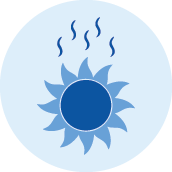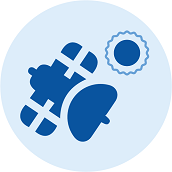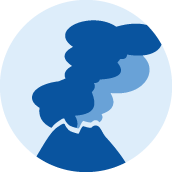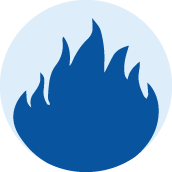Volcanic activityHūnga
Volcanic activity can include ashfall, falling rocks, hot gases and volcanic rock, lava flows, and massive mudflows. Find out what to do before, during and after volcanic activity.
On this page
About volcanic activity
In New Zealand, we have a lot of natural hazards. Earthquakes, floods, landslides, severe weather, tsunami, volcanic activity, and other hazards can happen any time and often without warning.
Volcanic activity can include ashfall, falling rocks, hot gases and volcanic rock, lava flows, and massive mudflows.
You can reduce the impacts of volcanic activity by finding out what the volcanic risk is in your area. Your local council may have resources and information on how to reduce potential damage.
You should also review your insurance regularly. Having insurance cover for your home and contents is important to help you get back on your feet if you suffer damage in a disaster.

We can't predict disasters, but we can prepare for them. One of the best places to start is with your home. Find out what you can do to make your home safer.
Get ready before volcanic activity
Get ready before volcanic activity. Talk to your Civil Defence Emergency Management Group to find out how they will warn you of a volcanic eruption.
Work out what supplies you might need and make a plan with your whānau.
Auckland, Bay of Plenty, Tairāwhiti, Hawke's Bay, northern Manawatū, Northland, Taranaki and Waikato are most at risk from volcanic ash fall.
If you are at risk, add the following to your emergency supplies.
Certified disposable dust masks (rated P2 or N95) and goggles
Plastic wrap or plastic sheeting (to keep ash out of electronics)
Cleaning supplies including an air duster, a broom, a shovel, and a vacuum cleaner with spare bags and filters
Heavy-duty plastic bags to dispose of ash
You could be stuck in your vehicle, so remember to store emergency supplies there too.

Make a plan online with your whānau to get through an emergency. Think about the things you need every day and work out what you would do if you didn't have them.

In an emergency, you may be stuck at home for three days or more. Your house is already full of emergency items disguised as everyday things. Figure out what supplies you need and make a plan to get through.

Find your local Civil Defence Emergency Management (CDEM) Group.
What to do during volcanic activity or if ashfall has been forecast
Know what to do during volcanic activity. Follow your Civil Defence Emergency Management Group online.
Follow official advice from:
- your Civil Defence Emergency Management Group
- the Department of Conservation (for Tongariro, Ngauruhoe, Ruapehu or Taranaki only)
- local authorities, and
- emergency services.
Check on your neighbours and anyone who might need your help.
During ash fall, stay indoors. Volcanic ash is a health hazard, especially if you have respiratory difficulties such as asthma or bronchitis.
- Do not attempt to clear ash from your roof while ash is falling.
- Keep pets indoors.
- Do not drive when there is ash on the road.
- Avoid unnecessary exposure to ash until it has settled. If you have to go outside, wear protective clothing:
- a properly-fitted P2 or N95-rated mask (or a cloth if you don't have a mask)
- goggles
- sturdy footwear
- gloves, and
- clothing that covers your arms and legs.
- Do not wear contact lenses because trapped ash can scratch your eyes. Wear glasses instead.
If ash fall has been forecast for your region
If ash fall has been forecast for where you are, go home if possible, to avoid driving or walking during ash fall.
- If you have a visual impairment, wear eyeglasses. Do not wear contact lenses because trapped ash can scratch your eyes.
- Bring pets inside and move livestock into closed shelters. Make sure that animals have supplementary feed and access to clean drinking water.
- Close all windows and doors and shut down heat pumps to limit the entry of volcanic ash. Set up a single entry point for your house. Place damp towels at the threshold to prevent ash being tracked indoors.
- Cover sensitive electronics. Do not remove covers until the indoor environment is completely ash free.
- Cover vehicles, machinery and spa pools to avoid ash causing damage. Ash can corrode metal surfaces and cause abrasion damage to windscreens and paintwork.
- Disconnect drainpipes/downspouts from gutters to stop drains clogging. If you use a rainwater collection system for your water supply, disconnect the tank.
- Check on your neighbours and anyone who might need your help.
What to do after a volcanic eruption and how to clean up
After a volcanic eruption, continue to follow official advice from:
- your Civil Defence Emergency Management Group
- the Department of Conservation (for Tongariro, Ngauruhoe, Ruapehu or Taranaki only)
- local authorities, and
- emergency services.
If you have evacuated, do not return home until told it is safe to do so.
Help others if you can, especially people who may need extra help.
Keep children indoors and discourage play in ash.
Keep animals indoors until ash is cleaned up or washed away. If pets go outside, brush them before letting them back indoors.
Check on your neighbours and anyone who might need your help.
If your property is damaged:
- Do not do anything that puts your safety at risk or causes more damage to your property.
- Contact your insurance company as soon as possible.
- If you rent your property, contact your landlord and your contents insurance company.
- Take photos of any damage. It will help speed up assessments of your claims.
Cleaning up ash
It is important to clean up ash promptly, as it is a health hazard and can cause damage to buildings and machinery.
When cleaning up, follow advice and instructions from your local council and Civil Defence Emergency Management Group. Be aware that:
- ash clean-up is physically demanding and time-consuming
- in bulk, ash is much heavier than people often expect
- repeated cleaning may be necessary, and
- water restrictions are likely after ash fall.
Use water very sparingly to avoid depleting water supplies.
Wear protective clothing that covers your arms and legs, sturdy footwear, a properly fitted P2 or N95 mask, and goggles.
If you have a visual impairment, wear eyeglasses. Do not wear contact lenses because trapped ash can scratch your eyes.
Clean up any ash indoors first to protect indoor air quality. Ash is much more abrasive than ordinary house dust. The best cleaning methods to prevent scratching damage are vacuuming and rinsing. Use water sparingly.
If possible, clean electronic equipment with an air duster to avoid scratching delicate surfaces.
Wait until ash has stopped falling before starting any outdoor clean-up.
Roof clean-up must be carefully planned as it is hazardous. Worksafe has advice for working safely at height.
For driveways and other hard surfaces, lightly wet the surface of the ash then use a broom to sweep up. Avoid dry sweeping as this creates high levels of airborne ash.
Remove ash from car paintwork and windscreens with water, but use water sparingly. Avoid rubbing as this can cause abrasion damage.
Follow official instructions about ash collection and storage. Contact your local council and your Civil Defence Emergency Management Group for more information.
Do not dispose of ash into drains as it can cause blockages and be difficult to remove.

Find information on working safely on roofs on the WorkSafe website.

First aid saves lives. Learn what to look for and what to do if you need to give first aid on the St John website.
Types of hazards | Ngā momo matepā
In New Zealand we have a lot of natural hazards. Find out what to do before, during and after each type of emergency.









